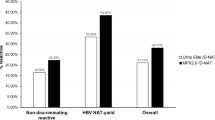Abstract
Even after the implementation of the nucleic acid amplification testing (NAT) system, there remains a residual risk of viral transmission through blood transfusion because of the limited sensitivity of the reagents used and the pooling strategy of the current NAT system. From the calculation using NAT yield and the length of the window period, we presume that we will obtain 0.75 donations for human immunodeficiency virus and 0.58 donations for hepatitis C virus annually that are individual donation-NAT positive but 50-individual pool-NAT negative, figures that are comparable with those in other developed countries. The number of donations potentially positive for the hepatitis B virus genome is, however, considerably high in Japan and is estimated to be more than 100 annually, which is the sum of the donors in the minipool-NAT window period and the chronic carriers with a low viral load. The incidence of bacterial sepsis after transfusion is relatively low in Japan. This incidence is possibly attributable to the short shelf lives of platelet concentrate and red blood cell component, which are 3 and 21 days, respectively. In Japan, the implementation of a new technology to screen out or abrogate infectious agents in blood components is necessary while considering the balance between benefits and possible new risks or costs.
Similar content being viewed by others
References
Otake K, Nishioka K. Nucleic acid amplification testing of hepatitis B virus. Lancet. 2000;355:1460.
Mine H, Emura H, Miyamoto M, et al. High throughput screening of 16 million serologically negative blood donors for hepatitis B virus, hepatitis C virus and human immunodeficiency virus type-1 by nucleic acid amplification testing with specific and sensitive multiplex reagent in Japan. J Virol Methods. 2003;112:145–151.
AuBuchon JP. Pathogen inactivation in cellular blood components: clinical trials and implications of introduction to transfusion medicine. Vox Sang. 2002;83(suppl 1):271–275.
McCullough J, Vesole DH, Benjamin RJ, et al. Therapeutic efficacy and safety of platelets treated with a photochemical process for pathogen inactivation: the SPRINT trial. Blood. 2004;104:1534–1541.
Atance R, Pereira A, Ramirez B. Transfusing methylene blue- photoinactivated plasma instead of FFP is associated with an increased demand for plasma and cryoprecipitate. Transfusion. 2001;41:1548–1552.
Satake M. Residual risk of transfusion-transmitted diseases in Japan and pathogen inactivation. Vox Sang. 2002;83(suppl 1):277–279.
Muller-Breitkreutz K. Results of viral marker screening of unpaid blood donations and probability of window period donations in 1997. Vox Sang. 2000;78:149–157.
Schreiber GB, Busch MP, Kleinman SH, Korelitz JJ. The risk of transfusion-transmitted viral infections: the Retrovirus Epidemiology Donor Study. N Engl J Med. 1996;334:1685–1690.
Matsumoto C, Tadokoro K, Fujimura K, Hirakawa S, Mitsunaga S, Juji T. Analysis of HBV infection after blood transfusion in Japan through investigation of a comprehensive donor specimen repository. Transfusion. 2001;41:878–884.
Matsubayashi K, Nagaoka Y, Sakata H, et al. Transfusion-transmitted hepatitis E caused by apparently indigenous hepatitis E virus strain in Hokkaido, Japan. Transfusion. 2004;44:934–940.
Wendel S, Fontao-Wendel R, Germano S, Morato LE, Lazar A, Sakashita A. Screening of bacterial contamination in a routine scale for blood components production in a Brazilian blood bank. Vox Sang. 2000;78(suppl 1):376.
Mohr H, Knuver-Hopf J, Gravemann U, Redecker-Klein A, Muller TH. West Nile virus in plasma is highly sensitive to methylene blue-light treatment. Transfusion. 2004;44:886–890.
Mather T, Takeda T, Tassello J, et al. West Nile virus in blood: stability, distribution, and susceptibility to PEN110 inactivation. Transfusion. 2003;43:1029–1037.
Grass JA, Wafa T, Reames A, et al. Prevention of transfusion- associated graft-versus-host disease by photochemical treatment. Blood. 1999;93:3140–3147.
Corash L, Lin L. Novel processes for inactivation of leukocytes to prevent transfusion-associated graft-versus-host disease. Bone Marrow Transplant. 2004;33:1–7.
Ciaravino V, McCullough T, Dayan AD. Pharmacokinetic and toxicology assessment of INTERCEPT (s-59 and UVA treated) platelets. Hum Exp Toxicol. 2001;20:533–550.
Engelfriet CP, Reesink HW, Klein HG, et al. The future use of pathogen-inactivated platelet concentrates. Vox Sang. 2003;85:54–66.
Author information
Authors and Affiliations
Corresponding author
About this article
Cite this article
Satake, M. Infectious Risks Associated with the Transfusion of Blood Components and Pathogen Inactivation in Japan. Int J Hematol 80, 306–310 (2004). https://doi.org/10.1532/IJH97.04118
Received:
Accepted:
Published:
Issue Date:
DOI: https://doi.org/10.1532/IJH97.04118




